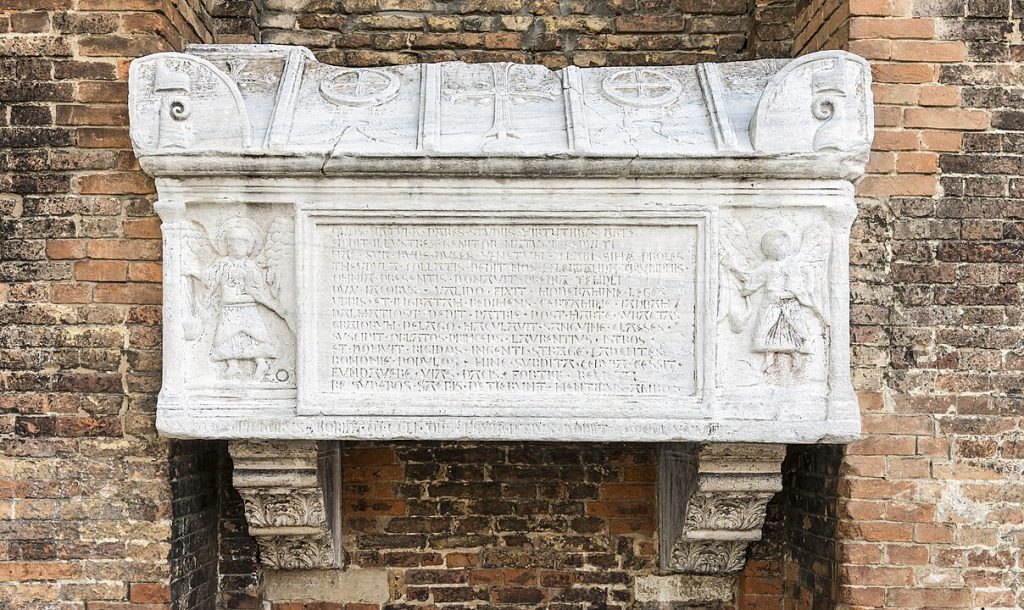Jacopo Tiepolo, the 43rd Doge of Venice, served from 1229 until his abdication in 1249. He died shortly afterwards on 19th July of the same year.
A key figure in Venetian history, Tiepolo’s reign was marked by significant political reforms, military campaigns, and infrastructural advancements that solidified Venice’s power and influence in the Mediterranean.
Born into a prominent Venetian family, Tiepolo’s early life is shrouded in relative obscurity, typical of many medieval figures. However, his political acumen and military prowess became evident through roles he held prior to becoming Doge.
He served as the podestà (chief magistrate) in Constantinople, where he demonstrated his ability to govern effectively and enforce Venetian interests.
In 1209, he was named as the first Duke of Crete, which he held until 1214. As such Tiepolo supervised the establishment of a Venetian colony on the island which had been purchased by the Republic from Boniface of Montferrat. In 1211, a major revolt broke out against Venetian domination by the Greek inhabitants of Crete. Aided by the Genoese, the Greeks rose in revolt, so that Tiepolo was forced to call upon the aid of the Venetian lord of the Duchy of Naxos, Marco Sanudo.
Tiepolo also served as podesta for Treviso, twice, and was a ducal councillor in Venice in 1228.
Reign as Doge
Elected Doge in 1229, Jacopo Tiepolo inherited a Venice poised for growth yet facing several internal and external challenges. One of his first significant acts was to address the political structure of the Republic.
He introduced reforms that aimed at balancing the power among the nobility, merchant class, and the broader citizenry. This included the establishment of the Great Council, which became a cornerstone of Venetian governance, ensuring a more inclusive and representative political system.
Tiepolo also promulgated new laws on commerce (1229), criminal law (1232), and codified civil law in the 1242 Statutum novum.
Military and Diplomatic Efforts
Tiepolo’s tenure saw numerous military campaigns aimed at protecting and expanding Venetian territories. He led efforts to secure Venice’s dominance in the Adriatic Sea and along crucial trade routes. His military strategies were not just about conquest but also about ensuring the safety and prosperity of Venetian merchants, who were the backbone of the Republic’s economy.
One of the notable military endeavours was his involvement in the conflict with the Holy Roman Empire. Tiepolo skilfully navigated the complex political landscape, maintaining Venice’s autonomy while forging strategic alliances. His diplomatic efforts extended to the Byzantine Empire, with whom he negotiated to secure favourable trade agreements that bolstered Venice’s economic position.
Infrastructural and Cultural Contributions
Jacopo Tiepolo’s reign was not solely about politics and war. He understood the importance of infrastructure in maintaining a prosperous state. Under his leadership, significant projects improved Venice’s infrastructure, including the expansion of the Arsenale, which became one of the largest shipyards in Europe. This not only enhanced Venice’s naval capabilities it also provided employment and stimulated the local economy.
Tiepolo was also a patron of the arts and architecture. His contributions to the beautification of Venice included the construction and restoration of churches and public buildings, reflecting the wealth of the Republic. These projects often featured artworks that highlighted Venice’s artistic achievements and religious devotion.
Related article: Ten facts about Venice
Abdication and Legacy
In 1249, after two decades of rule, Jacopo Tiepolo chose to abdicate, an uncommon decision that underscored his recognition of the importance of stable and continuous leadership. His retirement was short-lived; he died in July, having abdicated only two months earlier.

Tiepolo’s first wife Maria Storlato bore him four children, three sons and a daughter. Lorenzo followed in his father’s footsteps becoming doge from 1268 to 1275. Pietro also carried on the family name by becoming podesta of Treviso, whilst Giovanni was a military commander.
Tiepolo’s second wife, Vladrada of Sicily bore him two children whose identities remain unknown.
The reforms Tiepolo implemented laid the groundwork for Venice’s political structure for centuries. His efforts in expanding and securing Venetian territories ensured the Republic’s prosperity well into the future.





